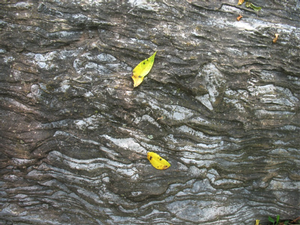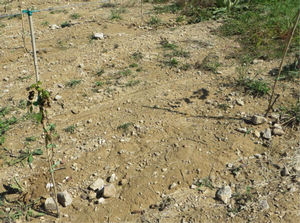Wine-growing and Terroir at North Mountain Vineyards
The grape vines at North Mountain Vineyards produce wine of distinction, expressing the unique characteristics of our vineyard soils, landform, and climate. These characteristics define our terroir (a French word used to describe a vineyards complete growing environment).
The soils at North Mountain Vineyards are developed on a sequence of ancient carbonate rocks and sandstone, which have produced two distinct soil types within our vineyards. Our easternmost hill we call Sonnenberg, and the tan-brown soils there are influenced by layers of sandstone, which have contributed abundant sandstone gravels, pebbles and cobbles to create a gravelly-silty loam. Our more westerly vines are planted on gently rolling slopes overlying limestone. The deep reddish-brown soil found there is classified a clayey-silty loam, and contains abundant highly-weathered chert nodules (microcrystalline quartz). Both soils are composed primarily of insoluble residuum resulting from the prolonged weathering of underlying limestones and sandstones. Minerals present generally include quartz and potassium feldspar along with minor clay and iron-oxides. Carbonate minerals are almost entirely absent in the soils at the surface due to weathering, but their presence even in minor amounts has a buffering effect that contributes to an overall soil pH of about 6.5.
Our gently rolling hills are sufficiently sloped to deflect springtime frost, and being situated between the Blue Ridge and the Allegheny Mountains offers a rain shadow that actually lessens our rain amounts. Minimal rainfall amounts can enhance wine quality, with Shenandoah County having not only the lowest average precipitation in Virginia, but one of the lowest overall averages in the eastern United States. Our elevations of about 1000 feet help to moderate both daytime and nighttime temperatures, and sufficient sunshine baths our vines throughout the growing season to ripen all our varietals to tasty perfection.
Geologically, our vineyards lie within the Conococheaque Limestone, an approximately 500 million year old Cambrian aged rock unit that represents sediment deposited in a shallow marine tidal environment. These particular limestones are referred to as “ribbon-rock” limestones because of their distinctive and beautiful layering. These rocks contain stromatolites (fossil algae beds), brecciated (broken-up) layers, slumped layers, and alternating beds of dolomite and limestone, which suggest various periods of sea level rise and fall associated with daily and seasonal tidal fluctuations.

RIBBON ROCK SHOWING ALTERNATING LAYERS OF LIMESTONE AND DOLOMITE
How do the climate and landforms, and composition of our soils influence the wines grown at North Mountain? The only way to evaluate the effects of terroir is to taste the wine. The broad view is that the red wines of North Mountain are of mild acidity, ruby colored, and commonly carry notes of plum and brambleberry. The white wines are generally spicy and fruity, with flavors and aromas of tree fruits such as apple and pear, with subtle tropical mango notes on the finish. Yearly seasonal variations in weather generally cause the intensity of these characteristics to be quite varied, thus our wine vintages can be quite varied as well. But the overall characteristics of our wines are predictable, as they are predictably different from the other growing regions of Virginia.
All the soils of our vineyard are classified within the Frederick-Poplimento silty loam. However, as mentioned above, our soils change from west to east across our vineyard. Our original plantings of Chambourcin, Vidal Blanc, Traminette, Chardonnay, Cabernet Franc, and Cabernet Sauvignon vines are on the more westerly limestone soils. In our more easterly Sonnenberg Vineyard (in German meaning the “Sunny Hill”) we have planted the varietals Petit Verdot, Cabernet Sauvignon, Zweigelt, and Riesling, which were first harvested in 2013.
We feel that likely there will be subtle differences in wine character between wines grown on our different soil types due to these differences in soil composition. The Sonnenberg soils have much lower water and nutrient holding capacity, are much better drained, contain more sand and rock fragments, and are more rapidly warmed. Such conditions generally help to reduce vegetative growth in the vines, thus potentially enhancing wine quality.

SONNENBERG SOIL WITH SANDSTONE FRAGMENTS
As we strive to understand the relationship between the soils of North Mountain Vineyards and our wines, it is clear that considerations of terroir are important when tasting our wines. The fortunes of an ancient shallow sea, millennia of geological processes, curvaceous landforms, Shenandoah Valley sunshine and a little bit of rain, have together conspired to create the terroir we have chosen to grow the wines of North Mountain Vineyards. We hope you enjoy the results.